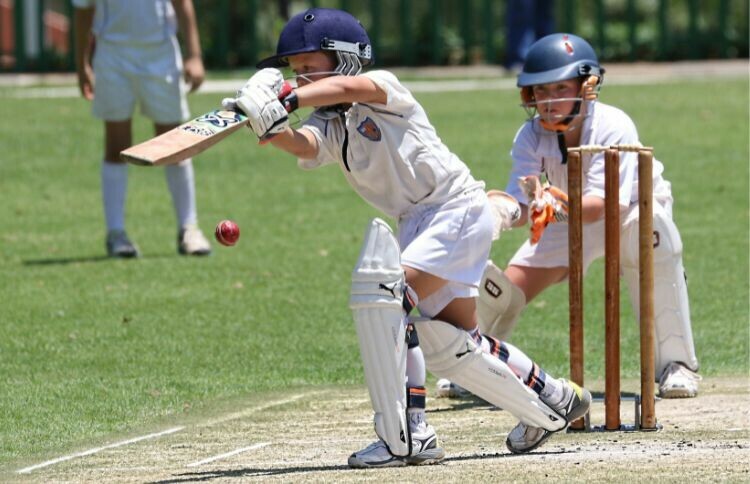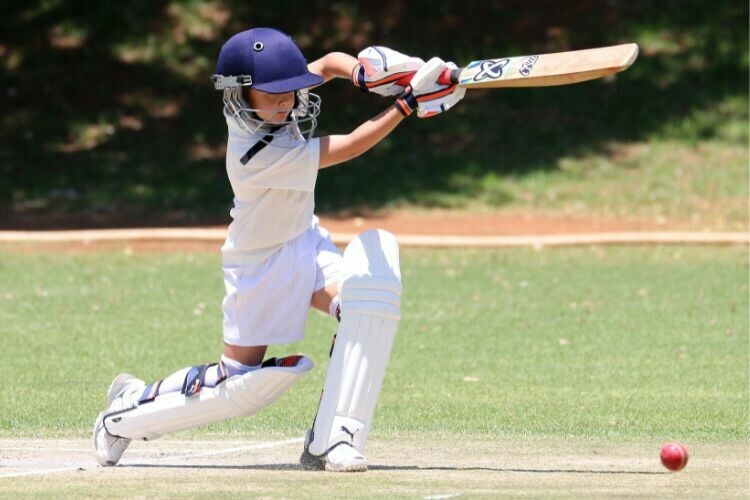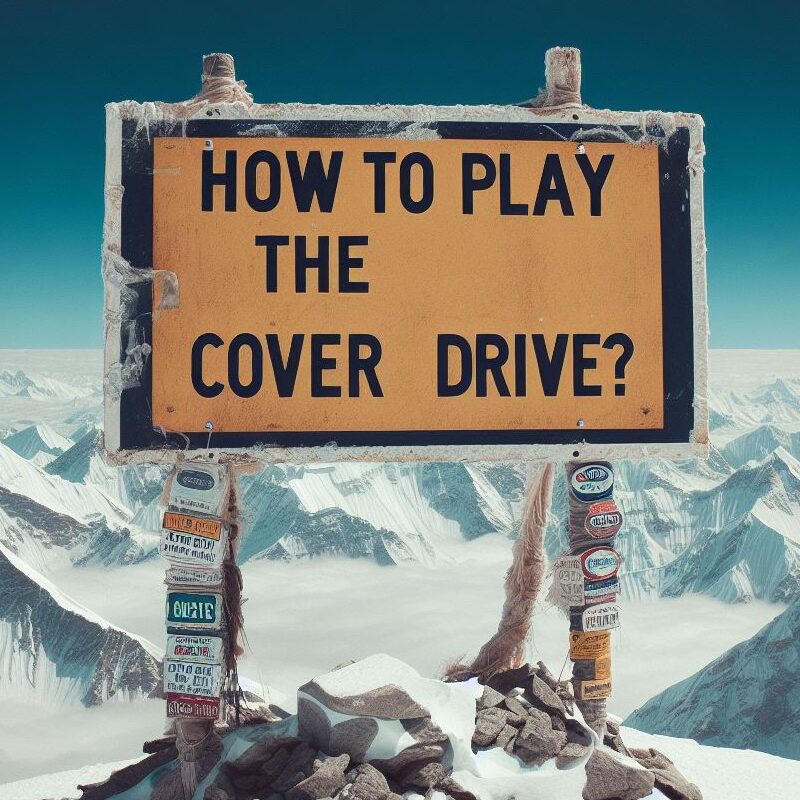Welcome to this blog post on how to play the cover drive. We’ve been progressing through the different shots available to you, the batter, and today we are talking about one of the great shots. The cover drive, when done perfectly and with great timing, is the kind of shot that batters hold in their follow through, as if waiting for the cameras to take a photo of them. It is both powerful and elegant.
To break the shot down, a cover drive is a front foot shot hit through the covers, typically with a straight bat and a full swing. It serves as a potent weapon in any batter’s arsenal, allowing you, as the batter, to score runs quickly by placing the ball into the gaps and piercing the field.
It is a shot that shows that you are in control, dictating the pace of play and commanding respect from the opposition.
You find the cover drive played in all forms of cricket; in limited overs games, the cover drive might be a lofted shot that bounces in the outfield, or even in the stands. In test matches, it is usually played along the ground, through the field, although, depending on the match situation, a lofted cover drive for six is definitely one way to signal that you are in control on proceedings.
Step-by-step breakdown of the cover drive
Stance: As happens with every cricket shot, the cover drive begins with your stance. It should be balanced and aligned towards the line of the delivery. Usually, this will be to a ball that is a little wide of off stump.
As the bowler releases the ball, judge the line and length of the ball. For a cover drive, the initial movement is forwards, so step forwards and shift your weight onto the front foot. Keep your head still and eyes level.
Then bring the bat down in a straight line, meeting the ball with a full swing of the bat, aiming for a gap in the covers region.
Foot positioning: The positioning of your feet is crucial. If your feet are stuck on the crease, you will likely be too far from the line of the ball to perform a controlled cover drive. Commentators call this reaching for the ball, when your hands and bat are far outside the line of your eyes.
Therefore, to perform a good cover drive, your first movement may have to begin just as the bowler bowls the ball. This is not a fully fledged movement out towards the direction of the ball, but a small movement that allows you to quickly react to the direction and line of the ball.
This is sometimes known as a batter’s trigger movement; it’s the movement that a batter makes for every ball that gets their feet moving. It is far easier to take a big step forward or back if your feet have already made a movement.
Now, once you have determined the line and length of the ball, your front foot should move towards the pitch of the ball, positioning itself close to the line of the delivery. The back foot should remain rooted in a position of strength and stability.
Grip and bat swing: Your grip on the bat should be firm but relaxed. You should allow yourself some flexibility and maneuverability during the strike to guide the ball in the gaps. As the bat comes down to meet the ball, the arms should extend fully, ensuring maximum bat speed and follow-through.
When you hit the ball, your front foot should already be in position. You should not be still in the process of moving your front foot when you hit the ball. In fact, if you have performed the shot well, you should be able to hold your position, post follow through, and not feel the urge to adjust the positioning of your feet.
If you do need to adjust the position of your feet, then perhaps you weren’t fully balanced at the time of the shot, and this might be something for you to practice in the nets.
Mastering Timing in the Cover Drive

Timing is the essence of the cover drive; if the sweet spot of the bat meets the ball at its optimal position, the ball will rocket to the fence will little additional power on your part, particularly if you are facing a fast bowler. Proper timing allows you to minimize the risk of mistimed shots going to the fielders in the inner field or edges going to the keeper or slips cordon.
Dedicate focused practice sessions to refining your timing. Start by warming up with basic drills to loosen up your muscles and establish a rhythm at the crease. Gradually progress to specific cover drive drills, where you can focus on timing the ball off a batting tee, or with throwdowns from a coach or a team mate.
You can also incorporate visualization techniques into your practice routing, mentally rehearsing the cover drive and visualizing executing the shot with perfect timing. This mental imagery can help reinforce the muscle memory required for precise timing in actual match situations.
Also, include reflex-building exercises to improve your ability to react quickly to incoming deliveries. Use reaction balls or hand-eye coordination drills to challenge your reflexes and simulate the unpredictability of match conditions.
Practice anticipating the ball’s trajectory by tracking the bowler’s release point and reading the line and length of each delivery as early as possible. By honing your ability to pick up cues from the bowler’s action and the pitch conditions, you’ll be better equipped to time the cover drive effectively and capitalize on scoring opportunities.
Strategic Shot Selection and Decision Making
Shot selection is a strategic art that can make or break your innings. The cover drive is a versatile stroke that can be employed in a wide range of match conditions.
However, certain factors may influence it’s effectiveness; these can include pitch conditions, the bowling attack and the current match situation.
Assess the state of the pitch; is it flat, which would make it conducive to batting and for attacking strokes like the cover drive, or is it likely to offer assistance to the bowlers with movement off the surface? In which case, you may need to get your eye in and used to the movement of the ball before bringing out the attacking drives.

Now, consider the quality of the bowling attack you’re facing – their strengths and weaknesses. If you’re up against pace bowlers who are offering you width outside the off stump, or spinners pitching the ball up, the cover drive will become an important and potent scoring option.
Conversely, challenging conditions where the ball is swinging or seaming, may require a more cautious approach.
When to choose the cover drive over other shots
The decision to play the cover drive or play the vast range of other shots at your disposal will depend on a variety of factors.
First and foremost is the line and length of the delivery. A ball pitched up outside off stump is the best ball to hit with a cover drive. If the ball is a bit shorter, you might go back on to the back foot to play the drive; if it is short and wide, you might think about a cut short; if it is full and wide, you might think of a square drive; and if it is on the stumps, you have the option of the on or off drive.
A second factor is your own skillset. Are you comfortable playing a cover drive? Obviously, if the answer is no, practice it more in the nets before bringing it out in a game.
Another factor is the field placements the opposing captain sets. If the captain has plugged up the cover region, he may be wanting you to lift the ball over the field, which increases the risk of a false shot and an early departure.
By developing a keen understanding of match conditions and adopting a strategic approach to your shot selection, you’ll be better equipped to wield the cover drive, maximizing your scoring potential while minimizing the risk of dismissal.
Correcting Common Mistakes and Perfecting the Cover Drive
Some common errors you might come across as you incorporate the cover drive into your repertoire are: mistiming the shot, playing across the line, and failing to maintain balance throughout the stroke. These errors lead to catches hit to fieldsman or edges nicked to the keeper or slips.

To address mistimed shots, focus on improving your footwork and timing by practicing drills that emphasize proper weight transfer and bat swing. Work on playing the ball closer to your body, ensuring that you meet it with the middle of the bat for better control and placement.
To prevent playing across the line, refine your alignment and ensure that your head remains still and eyes level throughout the stroke. Practice playing straight and driving through the line of the ball, rather than reaching for deliveries outside the off-stump.
To avoid the mistake of failing to maintain your balance throughout the stroke, concentrate on your stance and posture. Keep your head steady and your body well-balanced, with your eyes firmly on the ball. Practice drills that emphasize maintaining equilibrium from the backswing through to the follow-through, ensuring that you stay in control of the shot at all times.
Balance is the foundation of a flawless cover drive, so devote ample time to perfecting this aspect of your batting technique.
How different pitches and weather conditions impact the cover drive:
The state of the pitch can have a significant impact on the execution of your cover drive. On flat, true pitches with even bounce, you have the luxury of playing the shot with more freedom and aggression, trusting the bounce and pace of the ball to come onto the bat where you expect it.
On slower pitches with uneven bounce, you might need to exercise caution and play the cover drive with more control and precision to avoid edging the ball.
Weather conditions, such as moisture in the air or overcast skies, can affect the behaviour of the ball. In damp or humid conditions, the ball might swing more, or move off the pitch more, requiring you to adapt your technique and shot selection accordingly.
To adapt your shot, experiment with slight adjustments to your stance, footwork and bat swing to account for variations in pitch conditions and ball behaviour.
In challenging weather conditions, prioritize survival over aggression and look to play the cover drive with more compact and controlled technique. Focus on keeping your head still and eyes level, and be prepared to adjust your timing and footwork to account for any movement off the pitch.
Last Word On The Cover Drive
The cover drive is well worth the time and effort you put in to practicing it in the nets. If you perfect a great cover drive the goes to the boundary, it is a statement. It is a statement to the bowler that if you makes even a fine error in line and length you are skilful enough to capitalise on the mistake and get full reward for it.
The bowler will then have this on their mind for the next ball, and all deliveries after that. With his mind focused on what you can do, they are not focused on what they need to do. And so, one mistake becomes many, and you have won the mind game.
I hope you have enjoyed this post. Leave a comment below if you have a memory of a cover drive hit by your favourite player. We’d love to hear from you.
And come back soon to continue on this series with our post on How to Play the Square Drive.

